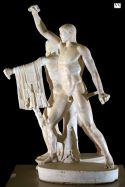
Art History vs. History? Reassessing the “Greek Revolution” in Art: Sources, Monuments, Contexts, Chronology
Scuola Normale Superiore, Pisa (Italy) Gianfranco Adornato
November 18, 2021 · 4:30 pm—6:00 pm · Zoom
Department of Art and Archaeology

Generally speaking, in art period names have been of three kinds: political-dynastic (i.e., Periklean, Augustan or Carolingian), cultural (i.e., Medieval or Renaissance) and aesthetic (Classic, Mannerist, Baroque, for instance). The chronology of art history has tended to associate stylistic and formal terminology with historical events and specific dates. The seminar focuses on periodization in ancient art history, on aesthetic notions and judgments in ancient literary sources, and on the creation of modern stylistic/cultural classification like the “Severe Style Period”. Conventionally this stylistic phase spans from 480 to 450 B.C.E. and is generally associated with a new style adopted by artists soon after the Persian Wars and with the sculptural group of the Tyrannicides by Kritios and Nesiotes. In this lecture, I would like to deeper examine some innovations and inventions in sculpture and architecture between 530 and 480 BCE: this survey will shed new light on the supposed Greek Revolution and on the novelties of the so-called Severe Style Period in Greek art. The seminar investigates Western Greek monuments and votive offerings connected to the aftermath of the battle of Himera (480 BCE). Since Diodorus (11 26 2) attests the construction of two temples, scholars have identified these sacred buildings with the temple at Himera on the very spot of the battle and the Athenaion in Syracuse. Recent investigation of materials from the fill underneath the Athenaion has questioned the chronology of the temple and its connection with the celebration of the battle. I propose that is not possible to distinguish such a “Severe Style Period”, since technical and stylistic improvements are detectable on statues and architecture dating from before 480 B.C.E., and that a paradigm of continuity (with many revolutions), as suggested by ancient literary sources and archaeological evidence, is preferable, in place of a clear-cut division of artistic periods and styles.















